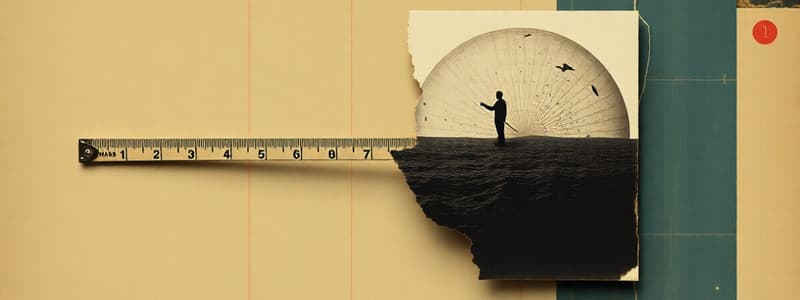Podcast
Questions and Answers
A $100$ g block of aluminum has a larger volume than a $100$ g block of steel.
A $100$ g block of aluminum has a larger volume than a $100$ g block of steel.
True (A)
The density of a substance can vary depending on its temperature.
The density of a substance can vary depending on its temperature.
True (A)
If you have two objects with the same volume but different masses, the object with the larger mass will have a lower density.
If you have two objects with the same volume but different masses, the object with the larger mass will have a lower density.
False (B)
It is impossible to determine the density of an irregularly shaped object.
It is impossible to determine the density of an irregularly shaped object.
If an object floats in water, it means the object's density is greater than the density of water.
If an object floats in water, it means the object's density is greater than the density of water.
The density of a gas is always lower than the density of a liquid.
The density of a gas is always lower than the density of a liquid.
A material's density is determined only by its composition, not by its shape or size.
A material's density is determined only by its composition, not by its shape or size.
To measure the volume of a rectangular block, you need to know its length, width, and height.
To measure the volume of a rectangular block, you need to know its length, width, and height.
Flashcards
Mass
Mass
The amount of matter in an object, measured in grams or kilograms.
Volume
Volume
The amount of space an object occupies, measured in cm³ or liters.
Density
Density
A measure of how much mass is packed into a given volume; calculated as mass divided by volume.
Measuring Mass
Measuring Mass
Signup and view all the flashcards
Measuring Volume (Regular Objects)
Measuring Volume (Regular Objects)
Signup and view all the flashcards
Water Displacement Method
Water Displacement Method
Signup and view all the flashcards
Factors Affecting Density
Factors Affecting Density
Signup and view all the flashcards
Density in Real Life
Density in Real Life
Signup and view all the flashcards
Study Notes
Understanding Mass, Volume, and Density
- Mass is the amount of matter in an object. Measured in grams (g) or kilograms (kg). It represents the amount of "stuff" in an object.
- Volume is the amount of space an object occupies. Measured in cubic centimeters (cm³) or liters (L). It indicates the space filled by an object.
- Density is a measure of how much mass is packed into a volume. Calculated by dividing mass by volume. A higher density indicates more mass concentrated in a smaller volume. Density = Mass / Volume
Measuring Mass
- Use a triple-beam balance or electronic balance to accurately measure mass.
- Note the units used (grams, kilograms).
Measuring Volume
- Regular Shaped Objects: Calculate volume using formulas (cubes, rectangular prisms, cylinders). For example, volume of a rectangular prism = length × width × height.
- Irregular Shaped Objects: Use water displacement. Submerge the object in a known volume of water and measure the change in volume. The difference equals the object's volume.
Calculating Density
- Use the formula: Density = Mass / Volume.
- Ensure consistent units (grams for mass, cubic centimeters for volume).
- Result will have units like grams per cubic centimeter (g/cm³).
Density and Substance Properties
- Different substances have different densities due to varying atomic/molecular packing.
- Density helps identify unknown materials if its mass and volume are known.
- Materials float if their density is less than water's (approximately 1 g/cm³). Denser materials sink.
Factors Affecting Density
- Temperature: Density changes with temperature. Warming usually decreases density, and cooling usually increases it.
- Material: Different materials have different densities (e.g., lead is denser than wood).
- State of Matter: Solids generally have higher densities than liquids, and liquids have higher densities than gases.
Examples and Applications
- Gold is denser than water.
- Wood is less dense than water.
- Archimedes used buoyancy and density principles in his inventions.
- Knowing material density helps engineers determine if a bridge can be built in certain environments.
- Density explains why some objects float and others sink.
Studying That Suits You
Use AI to generate personalized quizzes and flashcards to suit your learning preferences.




